Invincible and Legendary - The history of the Soviet Union during the Great Patriottic War
- Thread starter sebas379
- Start date
-
We have updated our Community Code of Conduct. Please read through the new rules for the forum that are an integral part of Paradox Interactive’s User Agreement.
You are using an out of date browser. It may not display this or other websites correctly.
You should upgrade or use an alternative browser.
You should upgrade or use an alternative browser.
And it is already mud-season. Wise choice, Germany.
I've seen them invade in December. This isn't so bad, they had to deal with the Allies first of course.
Once the rasputitsa is in full swing, the fascists are gonna have a bad time.
everyone is gonna have a bad time
DESTINY!
For the Motherland!
Nice and messy! Give them hell!
They will find nothing here but cold steel and shallow graves!
Those are some massive battles
And we've only just begun.
Invincible and Legendary
The history of the Soviet Union during the Great Patriottic War
The history of the Soviet Union during the Great Patriottic War
October 1941 part 1
Internal affairs
The Soviet airforce was reinforced in early October with 2 more fresh fleets of IL-10 Beast dive bombers and associated LaGG-3 escort fighters deployed in Kyiv. These aircraft would soon be thrown into combat to defend Lwow, where more and more German forces arrived daily.
Orders went out on October 3rd to raise another 4 armoured and 6 motorised divisions for the western front. These would forego the useual self-propelled artillery component for extra tank destroyers in the armoured divisions, after the major threat posed by German armour had become clear.
Battle of Bialystok
Indeed the deadly application of aerial power was amply demonstrated in September and early October during the battle of Bialystok. German infantry and armoured forces had advanced to the northern flank of the city and launched a massive assault on September 18th with the aim of capturing the fortress, a cornerstone in Soviet defences. Initially defended by the 50.000 strong 15th infantry corps. In addition high command had send one of the precious Soviet Heavy tank divisions to the city to further bolster its strenght. The city had indeed been turned into a virtually impregnable fortress, or so the Red Army thought.
Heavy German artillery and air strikes reduced much of the city to rubble and several infantry divisions of the 15th corps protecting the western approaches took heavy losses when German panzer-divisions joined the assault. Under extreme pressure, the troops fell back to the citadel and the decimated formations were withdrawn from the line. They were replaced by units of the 16th corps who stood their ground alongside the heavy tanks in what would become one of the bloodiest confrontations of the war. Wave after wave of German forces attacked Bialystok fom the north, west and southwest. Stuka dive-bombers reduce Soviet strongpoints, pacing the way for the advancing infantry. Despite attempts to swap out exhausted divisons with fresh defenders, bring up forces for a flanking counterattack or deploying air support, the citadel was breached and after severe fighting in the city an evacuation was ordered.
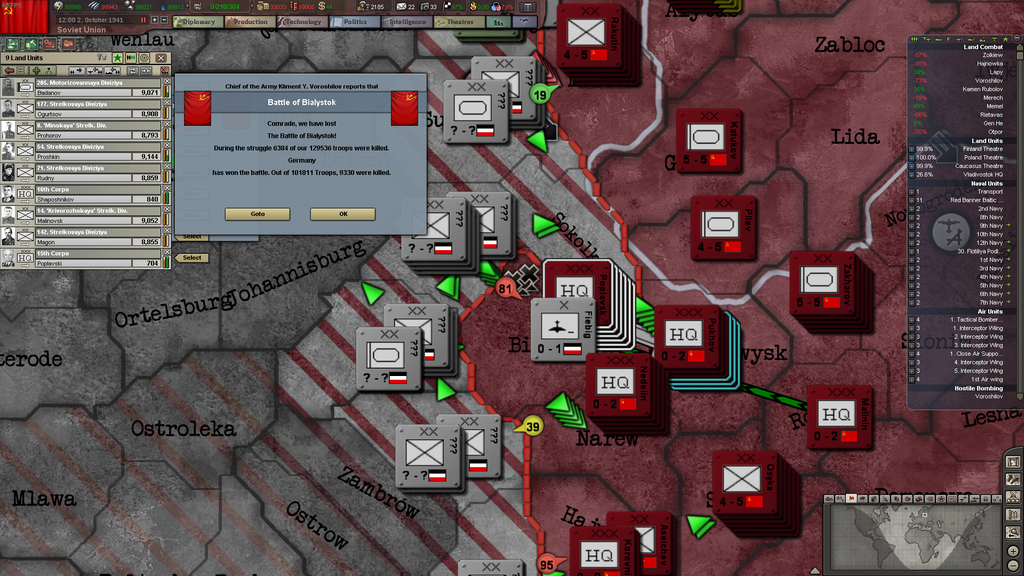
Finnish Front
Soviet infantry had breached the Finnish southern border early in the war,but the Finns had drawn up defences inland. But the Red Army had 10 divisions, outnumbering the Finns 2:1, an advantage that was exploited when an offensive was launched not just over the Karelian Isthmus, but also northwest of Lake Ladoga.

The offensive was a resounding succes, with most Finnish positions overrun by October 5th and Finnish casualties twice that of the Soviets. further up north, small scale fighting developed between individual Soviet and Finnish divisions in the forests of Central Finland. Superior Soviet firepower in the form of heavy artillery won the day and drove the Finnish defenders back inland. At Suomussalmi, a heavily forested region in the middle of the country, a single Soviet division breached the lines and routed 2 Finnish divisions.
By the second week of October, Soviet infantry had penetrated deep into the lakes in southern Finland. 2 Soviet divisions stayed on the Baltic coastline and began pushing towards Helsinki, whilst other fores headed deeper into Finland to engage the army. Despite being pushed back everywhere, the Finns turned and fought at every step, for example on the 16th, when 2 divisions in the south turned on the lone 97th Soviet infanty division advancing through Lappeenranta. After heavy figthing in the forest, resulting in some 800 Soviet and 1000 Finnish casualties, the division held on, but barely. Against better judgement general Potapov ordered the division forward to occupy Kouvola. His men held it briefly before being forced back out of the town by 2 Finnish divisions on the 20th.
After a brief rest his forces came back the next week and took the city. With a third Soviet infantry division flanking around the lakes north of this sector and attacking the Finnish defences arrayed before Helsinki from the flank, the defenders started falling back. The 126th infantry division stormed and seized the heights of Porvoo, the last defensive positions before Helsinki itself on the 28th of October. With the capital threathened and the army disperced and exhausted, Soviet High Command will soon be able to send much needed reinforcements south.
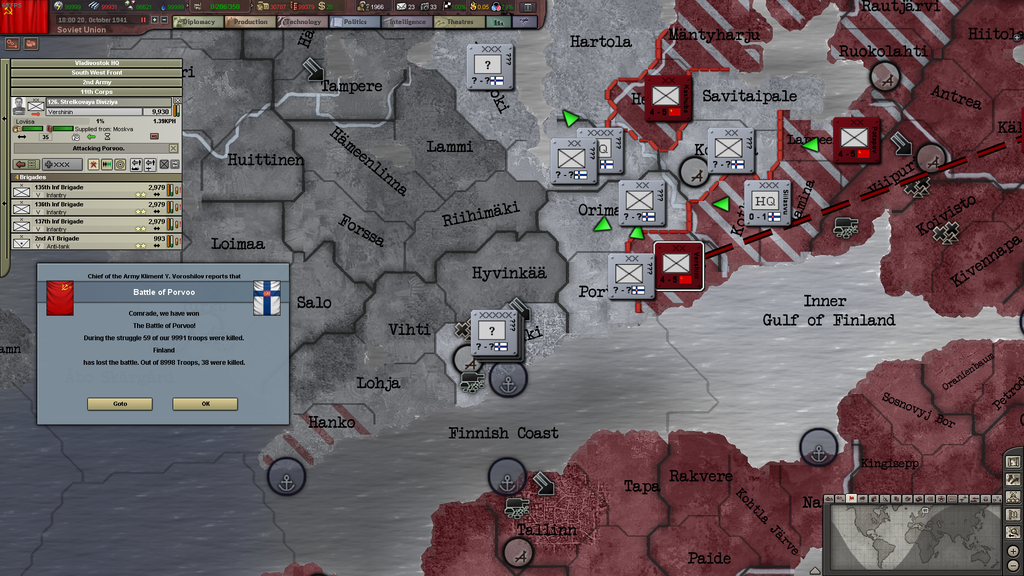
Baltic Front
Fighting in Lithuania raged on with the German offensive against Jurbarkas, just west of Kaunas. German forces had broken through west of these divisions and now launched both a frontal and flanking attack on the unfortunate 19th corps. The 40.000 Soviet infantry were faced with 65.000 German infantry, SS assault troops and light tanks charging their positions under heavy air cover. Though the corps put up fierce resistance and other Soviet infantry forces aunched a counterattack oon Mariampolé to relieve some pressure, it was eventually too much. Exhausted and low on ammunition the Russian infantrymen withdrew from their bloodstained trenches.
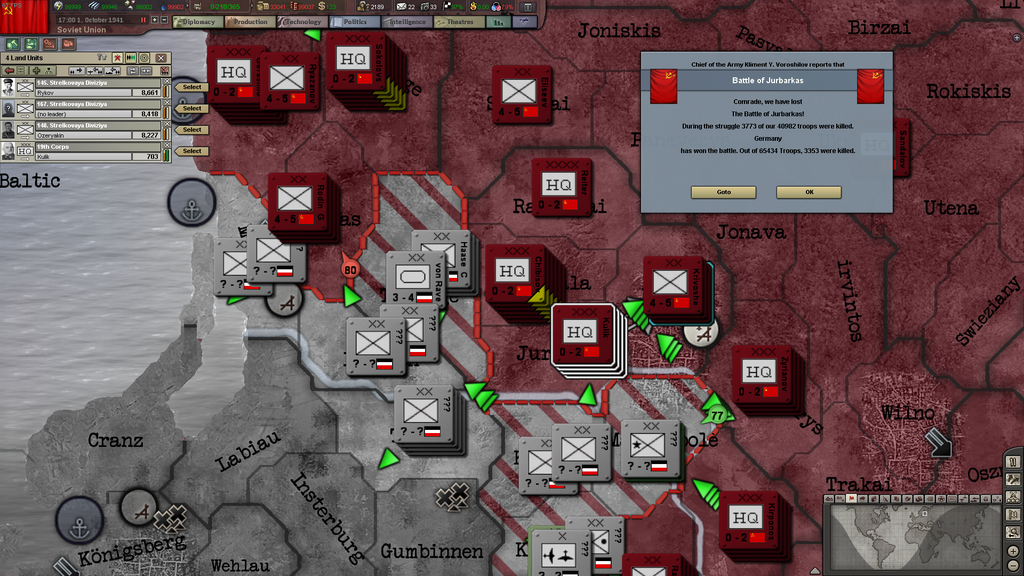
But the initiative in the Baltic sector would not be left completely to the Axis. The following day the Soviet 163. motorised division, since the Winter War upgraded to a full armoured division, spearheaded a counterattack on Mariampolé. 80.000 Soviet infantry and tank troops overran and crushed an Italian infantry division and forced an elite German SS division back with heavy losses of over 1500 men, thrice the Soviet dead. Another counterattack on the 3rd saw a Soviet infantry corps, with heavy naval gunfire support, overrun the German infantry lines around Memel. The Soviets did not advance however, because their flanks at Rietavas crumbled. Still the old Soviet battleships proved their worth in stopping German attacks.
The 2. Red Guard Corps, entrenched in the fields near Kaunas took the next German hammerblow on the chin. In a numerically roughly equal fight against German infantry and tanks they held the line on the 7th, at the cost of 2400 men on each side. Another Soviet counterattack on Memel failed on the 8th, despite killing 1700 Germans for only 1000 Soviet casualties.
Palanga fell in the following German counterattack on October 12th and the German army began to outflank the Soviet positions via the coast, despite the constant bombardment the Soviet battleships subjected them to. but the infantry and Red Guard divisions in Lithuania were not yet defeated, something the Germans would soon discover.
Polish Front
Soviet heavy armour and infantry entrenched just north of Brest Litovsk came under heavy German attack in late September. By October 2nd they had held the line, losing 1350 men to the German 2000 dead, though the troops were exhausted.
After Bialystok had succumbed to the Germans the situation deteriorated quickly. Positions in Lapy, east of the city, broke on the 4th as exhausted Soviet tank formations were unable to offer effective resistance.
With the critical central sector of the front in danger of collapsing, the 5 medium tank divisions of the 1. Mechanised Corps and the 2 light tank divisions of the 6th Cavalry corps moved up to bolster the lines at Bialystok. A bloody battle north of Lwow in the fields of Zolkiew cost 4500 men on each side, but the deployment of additional German panzer-divisions eventually broke through the Soviet lines.
With the northern flank of Lwow exposed, the city prepared for the inevitable German assault. The Soviet troops did what they could to prepare the city with strongpoints and reinforcements stood ready further back, but high command held its breath as reports of the first artillery bombardments came in on the 10th. Soon after, a battle erupted in the streets with both sides committing over 50.000 men to the first engagements.
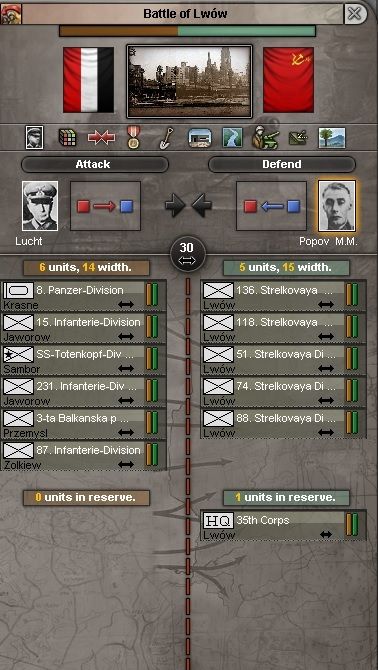
The attack coincided with German attacks all along the Baltic and northern Poland sectors, though these assaults were much less important than the bloody encounter in Lwow. They were more spoiling attacks than anything, though a Soviet counterattack did retake Jurbarkas after heavy fighting.
As the battle of Lwow entered its third day and much of the northern and western parts of the city had been reduced to rubble, assistance arrived in the form of the 6th Mechanised and 28th infantry corps. The great Battle of Lwow was turning into a clash of giant proportions as both sides fed reinforcements into the battlezone.
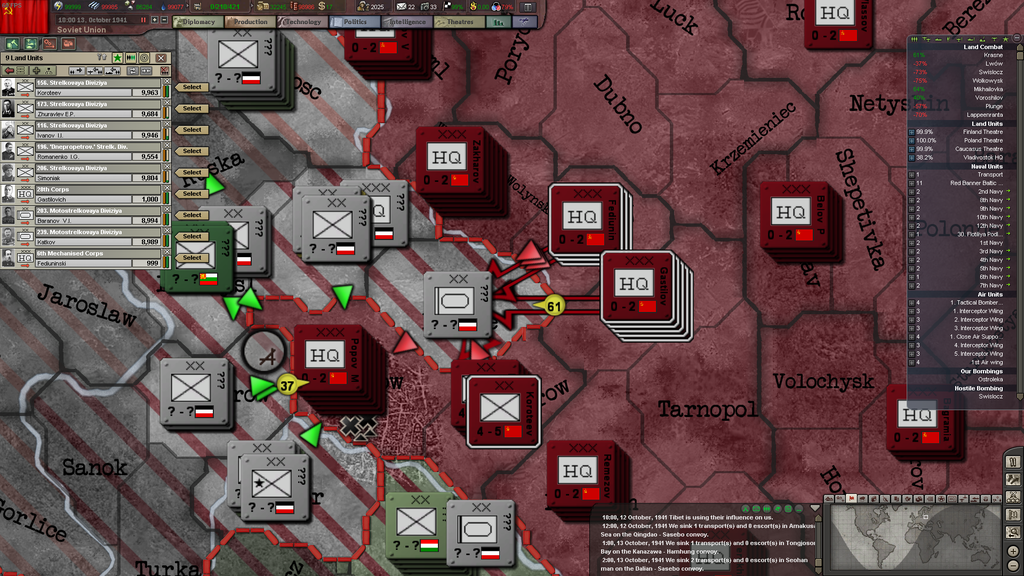
The Far Eastern Theatre
The Japanese continued their push east, towards Vladiwostok. Defences in Voroshilov held initially, but the fighting quickly exhausted the Soviet infantry and mountain troops, especially when the Imperial Guard was deployed. An antire Soviet infantry corps was only just able to stop 2 of these elite divisions in the hills north of Vladiwostok and the situation deteriorated fast. The entire front north of Vladiwostok began to give way and another Japanese attack in Mongolia breached local defences as well.
At sea, both sides continued to strike at one anothers convoys and on the 6th of October a minor skirmish between Soviet submarines and Japanese battleships occured in Tsushima Strait. No losses were reported on either side but the fleet would be more careful from now on, due to the increased Japanese patrols. Soviet submarines had more succes further south, sinking enemy convoys near Taiwan.
A major flaw in the Soviet defence plan was discovered as well when high command realised the Japanese marines advancing on Sakhalin could cross the strait unmolested. Despite the worsening situation in the south the Vladiwostok Garrison was rushed north by train to try and set up defences. This in spite of the still increasing Japanese pressure on the Vladiwostok sector as more enemy mountain and marine divisions arrived. Sporadic fighting in the suburbs of the city lasted until the 12th, when the Japanese withdrew after taking a few hundred casualties.
Last edited:
Some of those battles are seriously bloody. You should be alright with your high manpower but I wonder how Germany will cope even after a year of fighting like that?
Your position in Japan doesn't sound great though, if they're at the edge of vladivostok and breaking into mongolia.
Your position in Japan doesn't sound great though, if they're at the edge of vladivostok and breaking into mongolia.
Some of those battles are seriously bloody. You should be alright with your high manpower but I wonder how Germany will cope even after a year of fighting like that?
Your position in Japan doesn't sound great though, if they're at the edge of vladivostok and breaking into mongolia.
Germany has pretty good mp gain and they have plenty of reserves, I doubt any of the Axis major powers will be bled dry anytime soon. We'll have a better look at the Far East later, but trust me, that sector is going to get a lot worse before it gets better.
I agree. Bleed them white until they can't keep up the pressure.
The enemies of the revolution will drown in their own blood! Though it may take some time for that to take effect.
I realised I forgot an important note at the end of the Battle of Byalistok, which has been added. Yes that is sort of a setup to the next chapter and no, I won't say anything else.
Still, the German advances had been very slow so that's a small victory in itself. The east must be dealt with before the Japanese really make any progress.
Germany doesn't advance quicky, but fighting is fierce so the Red Army cannot afford to pull much from the front. Maybe, once the initial shock has worn off and the whole nation is set up for the long haul and the European threatre is stabilised something can be done. But as I said to TDM, the only spoiler I'll give you now is: things will get worse before they get better.Still, the German advances had been very slow so that's a small victory in itself. The east must be dealt with before the Japanese really make any progress.
Sucks that you couldn't exact revenge in Tsushima for the humiliating defeat there in 1905, but I suppose we should count our blessings.
You could just retreat to Dvina and Dniepr lines. Not much to lose west of those rivers.
Sucks that you couldn't exact revenge in Tsushima for the humiliating defeat there in 1905, but I suppose we should count our blessings.
All in due time, all in due time. There is absolutely no way one can beat the Imperial Japanese Navy with the ancient ships the Soviets start with, going there would be suicide. First the various fronts must be stabilised, and that is gonna take some time and effort.
You could just retreat to Dvina and Dniepr lines. Not much to lose west of those rivers.
But if I don't weaken the enemy before that, and damage the infra in the process, who guarantees they'll not just breach that too? Besides, no more territory than neccesary must be surrendered to the invaders!
Last edited:
The important thing is that unlike the RL Red Army you're avoiding kessels.
Thats the main goal initially. Even if territory is lost the army must be kept intact
Invincible and Legendary
The history of the Soviet Union during the Great Patriottic War
October 1941 part 2
The history of the Soviet Union during the Great Patriottic War
October 1941 part 2
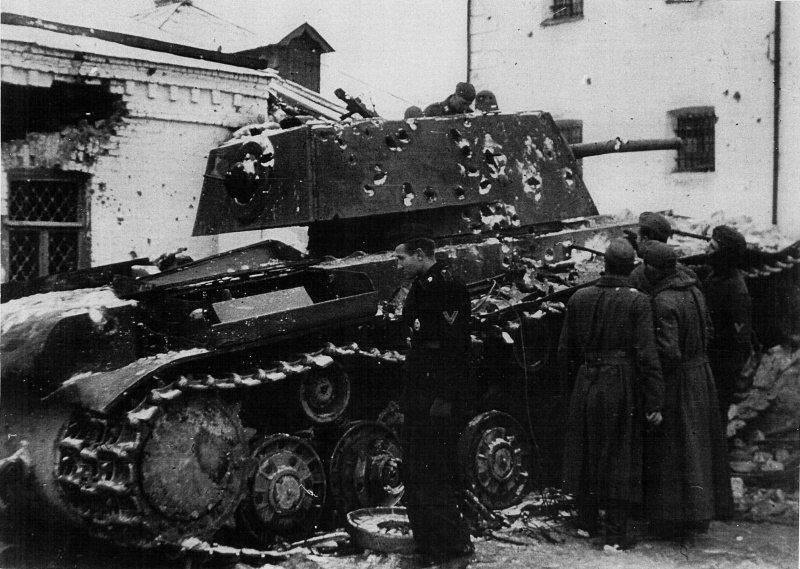
Destroyed Soviet heavy tank in the streets of Brest Litovsk, late October
Finnish Front
The 97th division, one of the 2 Soviet infantry divisions marching on Helsinki, was attacked in Lappeenranta by 2 Finnish divisions. The Russian solders however, veterans of the 1939 Winter War, kept their cool and fended off the attack until the Finnish flank on the Baltic coast was turned by another Soviet division crashing into it. Despite an 18.000-10.000 advantage in numbers the Finns break off the attack on the 17th of October and begin withdrawing towards Helsinki. Further north the Finns also pulled back deeper into the lake-rich forests of southern Finland, further and further away from Helsinki.
In the south, the advancing Soviet 97th division was struck in their flank by 2 Finnish divisions. Fearing an exhausting battle will leave them vunrenable to the Finns, general Potapov decided to withdraw and wait for his support, en route along the Finnish coast.
The harsh weather already raging in Finland at this time of year slowed down military operations significantly, but nevertheless the 126th division moved ahead, capturing Porvoo on the 28th of October.
Baltic Front
On the 14th of October the elite 1. Red Guard Corps launched a counterattack against German positions in Taurage. Soon they are backed by the reinforced Soviet 23rd corps in a flanking position, in order to provide the firepower needed to overwhelm the German tank divisions in the city. A total of 125.000 men are thrown against German positions less than 40.000 strong. Disregarding heavy airstrikes by German dive bombers and the presence of enemy armour, the troops press forward. After 2 days of heavy fighting and at the cost of almost 1800 Soviet and 2400 German lives, the city is retaken by the Red Guard.
The Germans begin another attack further north in Plunge. Despite losing 2400 men to only 1000 Russian losses they break through the 3 entrenched infantry divisions here. Regardless of this, the counterattack by the 2. Red Guard Corps continues, retaking Taurage. German heavy tanks have crossed the river further east however, and now occupy Jurbarkas, on the edge of Kaunas. Again the 2. Red Guard Corps, backed by the infantry holding the city, go on the offensive to retake the northern riverbanks. But the Germans have broken through on the coast and their tanks are already pushing into western Latvia, even Soviet battleship fire is unable to stem the assault. Either the Red Army has to bring substantial reinforcement forward soon, or evacuate Lithuania to avoid having their flank turned by the German tanks and SS.
Taurage is attacked once again the following week, but the Germans make a serious judgement error, attacking the 33.000 guardsmen in the city with only 15.000 of their own infantry. The result is a devastating defeat for the attackers, losing over 1000 men against just over 200 Red Guard casualties on the 20th of October. That same day, German heavy tanks are moved up towards Jurbarkas to reinforce the Bulgarian infantry now holding the bridgehead alone. But the Soviet counterattack strikes hard and fast, overrunning and routing the Bulgarians with 70 dead against 650 Bulgarians.
The Germans take a few days to re-organise and regroup their army in Lithuania before launching the next attack. Surprised by the presence of the Soviet elite Red Guard Corps on the frontline, the enemy brings his own elite SS divisions to bear in the next attack on Taurage.
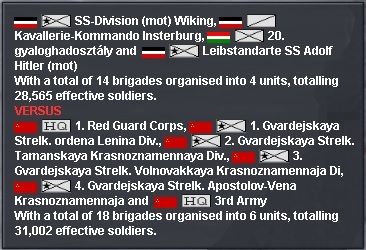
Elite assault troops facing each other in Taurage
The Soviet airforce has by now been all but exhausted in battle against the Germans and direct support to ground troops is limited. To remedy this situation, 2 additional air fleets of 2 Sturmovik ground attack aircraft wings and 2 LaGG-3 escort fighter wings are deployed to Riga. From here they will attempt to support the Baltic Front in their defence of Lithuania and Latvia.
The German offensive directed at Kaunas is called off on October 23rd after taking heavy losses estimated at over 1.000. With the city still in Soviet hands it can be used as an anchorpoint between the troops performing a fighting withdrawal in Latvia and Lithuania, and the static troops in Poland. That such operation is needed becomes abundantly clear after an entire German panzerkorps smashes its way into Vainode, north of Palanga, at the cost of 2400 Soviet and the same amount of German dead on the 24th.
A second attempt to take Kaunas, this time by Italian infantry, is foiled the next day, at the cost of 100 Soviet lives and 10 times that many Italians. The Regia Esceterio is clearly not aware of the military rule that taking fortified positions demands overwhelming odds.
A massive, 90.000 strong Soviet counterattack in Plunge blunts the German tank formations' advance, though at a high price. But the German tank division lost many of its armoured vehicles and 1800 men and is forced to withdraw from the front for refit.
The German Waffen-SS regroups and begins another vicious offensive in Lithuania in the third week of October. Once again they find the elite Red Guard Corps in their way and once again a bloody melée develops, lasting over a week. When the Germans disengage and the smoke clears on the 27th of October the full extend of the carnage becomes clear.
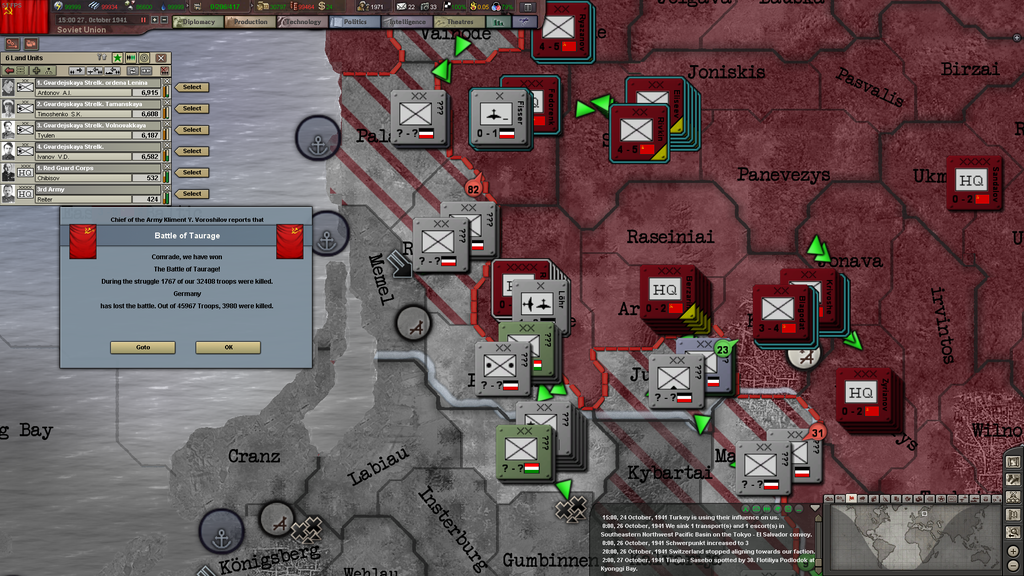
The third battle of Kaunas also ends this day, again in Soviet victory. This time the futile attack on the city was launched by German mountaineers. A single division was completely inadequate to drive a full infantry corps out of their defences and one German brigade loses 50% of its men. To prevent German forces in Mariampolé, south of Kaunas, from supporting the attack they are attacked and driven back by the 36th corps and a tank division. The line has been stabilised and for the moment a complete breakthrough in Lithuania has been prevented.
Polish Front
A ferocious battle erupts in Wolkowysk as German forces in Bialystok attempt to break through the Soviet second line east of the city. Narew, a critical city in between Bialystok and Brest-Litovsk is found lightly held as only 1 German infantry dvision appears present. A fresh Soviet infantry corps is immediatly thrown into a counterattack and overwhelms the division on the 15th. The ultimate goal of the attack is to try and attack Bialystok from the south, thus relieving pressure on the defenders of Wolkowysk.
But before this Soviet flanking maneuvre can be executed the German army begins its offensive to take Brest-Litovsk. Ferocious artilery barrages prepare the way for German infantry and panzers as they assault the fortress city from the north, northwest, west and south. Soviet infantry are well entrenched in their many strongpoints and large scale house-to-house fighting erupts throughout the suburbs as German infantry and tanks press forward.

The defenders put up fierce resistance and wear the German attackers down in a bloody battle of attrition. A few days into the fighting, German forces are exhausted and request their allies take over the attack to keep up the pressure on the city. 105.000 Italian and Hungarian infantrymen are thrown into the fray to replace the German attackers and keep the pressure on the 60.000 defenders.
Despite having been weakened by the earlier German assault, the defenders are not defeated yet and the Italian and Hungarian infantry lack the heavy support units of their German counterpart. As casualties mount on both sides, 1300 defenders and well over 1600 attackers, the assault is called off by Italian generals. The fortress city stands firm as of October 20th.
The Soviet 1st mechanised corps in Narew is outflanked and attacked from 4 directions north and west of their bases. Masses of German infantry and tanks throw themselves against the armoured divisions, who form an almost impregnable bulwark in the Soviet lines. But the Wehrmacht is determined to break this elite Soviet corps no matter the cost.

Other armoured divisions are ordered to delay the German assault on Brest-Litovsk by launching a counterattack in the same sector. German and Bulgarian forces are ready for the attack and call in heavy air support on the Soviet tankers advancing in the open. The result is a massacre as over 1300 Soviet soldiers and numerous tanks are lost in a fruitless frontal attack. Axis casualties are estimated at less than 200.
General Guderian leads a reinforced German panzercorps with substantial infantry support in the decisive assault on Brest-Litovsk. German medium tank brigades clash in the streets with Soviet heavy armour in a bloody tank battle.
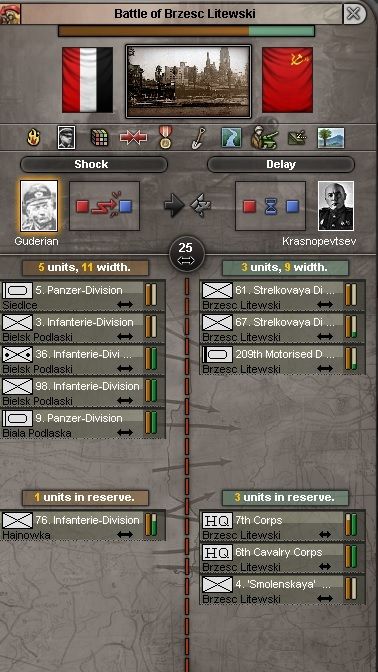
A German offensive against what is perceived to be the weak right flank of Brest Litovsk ends in a bloodbath. To their shock, instead of weakened infantry the Germans run headlong into general Rokossovsky's elite 14th Mechanised Corps and his 5 armoured divisions. 850 Soviet tankers and 2400 Germans and Italians fall in the battle before the Germans manage to disengage.
In a desperate bid to hold Brest-Litovsk, general Rokossovsky of the 14th mechanised corps gathers what armoured- and local infantry divisions he can and launches another counterattack north of the city. With the 7th tank division leading the way they slam into the German left flank. The result is an immediate and massive German counterpush.
Bulgarian infantry advanced to Krasne, east of Lwow in an attempt to force the defenders back by threathening their flank. Instead the lone division finds itself the target of a masterful counterattack by general Gastilovich' 28th infantry corps. Hitting the 8000 strong Bulgarians with 40.000 men of his own he loses only 121 whilst killing or capturing 1/8th of the Bulgarian division and driving the rest back in disarray on the 29th of October.
In the mean time fighting in the streets of Lwow continue in all severity, with 3 German infantry and 2 panzer divisions slowly pressing forward to the city center. 3 of the 4 defending divisions of 35th corps are all but exhausted, despite having relieved earlier defenders already. As more and more Axis divisions enter the fray and the defenders are unable to get their reinforcements to the frontline in the chaos, Soviet forces are pushed out of the city center and into the eastern suburbs in an orgy of bloodshed. 35th corps eventually collapses under the pressure and a general retreat is ordered by general Popov to avoid the complete destruction of his corps.
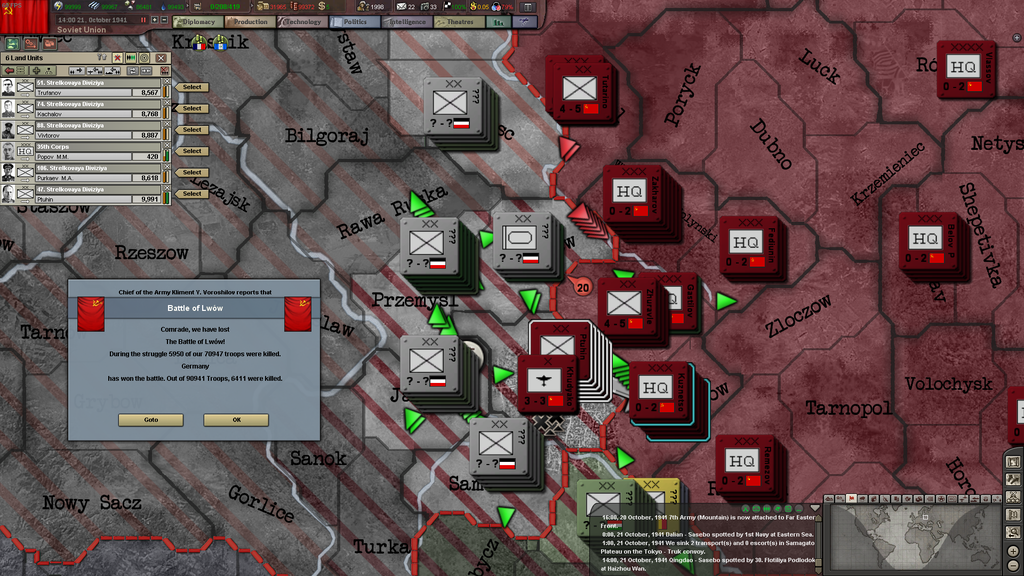
In response to the fall of this important city, and especially the ferocity of the fighting that preceded the fall of Lwow, the Soviet government finally orders the entirety of Soviet industry to be focused on military production with a so-called Heavy Industry Emphasis.
2 days after the fall of Lwow the Soviet counterattack on Zolkiew, that was launched to support the defenders, is called off. The suicidal, frontal attacks by red army infantry here add another 1100 German-Bulgarian casualties and almost 3000 Soviet losses to the total death toll of Lwow.
A combined 60.000 strong German-Bulgarian assault on Hajnowka, south of Bialystok, smashes into the 50.000 strong Soviet infantry corps entrenched in the area. A fierce struggle erupts as German assault troops and tanks drive a wedge in the Soviet positions, forcing the defenders back after a bloody battle in the forests leaves 2300 Soviet and 1900 Axis soldiers dead in the field on the 20th of October.
With Soviet lines crumbling in this sector and no more local reinforcements available, high command orders the 12th Mechanised Corps to rush forward from its base deeper inland. 3 fresh armoured divisions will have to prevent a German breakthrough northeast of the city. These troops arrive on the 25th and immediatly commence a brutal counteroffensive against the Germans holed up in Wolkowysk. Yet again the ruined city becomes a major battleground.
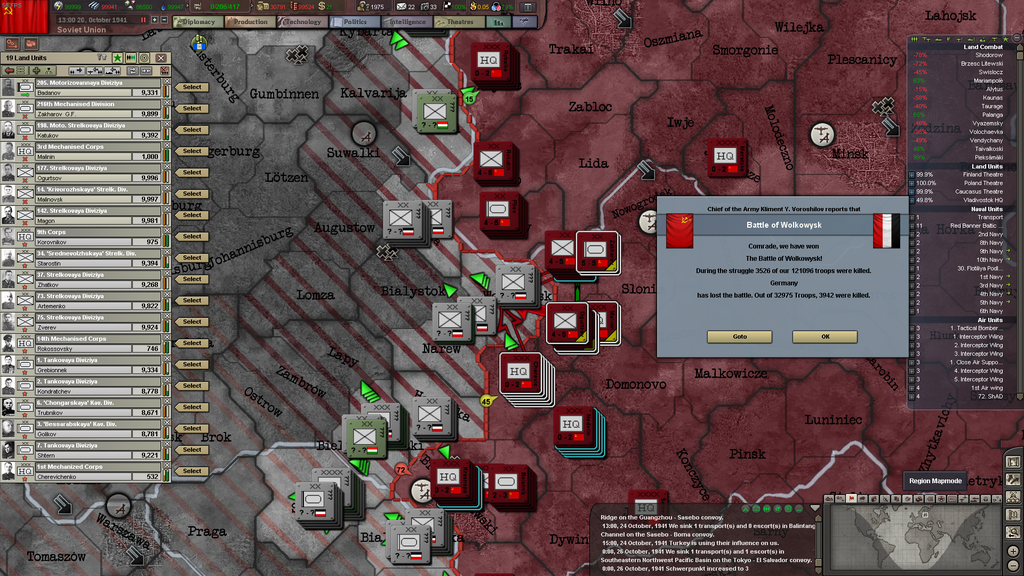
After weeks of ferocious fighting in the Brest-Litovsk sector of the front, many of the Soviet divisions fighting here are exhausted at the end of the month. The 1st mechanised corps counterattacks again and does drive the Germans back, inflicting 1600 casualties against 800 of their own. But more and more units are exhausted and high command doubts wether another major axis offensive can be held off as succesfully.
The divisions that were exhausted in the heavy fighting at Lwow, primarily the 5th and 35th corps take a vicious beating from a 4-pronged German offensive before they can withdraw from the bulge that developed in the Soviet lines. The German attackers take 1300 losses, but the retreating Soviet divisions are decimated, taking over 4000 casualties.
Ukranian front
The Ukranian front has thus far not seen much action in the war. Bessarabia was surrendered without much of a fight but a powerful defence had been prepared on the Dniester riverbank prior to the invasion. The Hungarian army occupied Stanislavow with a large force and then both they and their Romanian allies halted their advance to wait for German support. German infantry was deployed as a vanguard on October 20th to try and force the Dniester. The 16.000 strong assault force ran headlong into 40.000 entrenched soldiers of the Soviet 14th corps, resulting in a one-sided slaughter on the riverbank at Husiatyn. The Germans withdrew in the evening of the 21st, leaving 2250 dead in their wake. Less than 400 defenders had been killed in the fighting.
But the second major attack does not end as victorious for the Red Army. Despite the tough situation for the Germans, having to attack across the river with their tanks, they smash their way through the defenders in yet another bloody engagement.
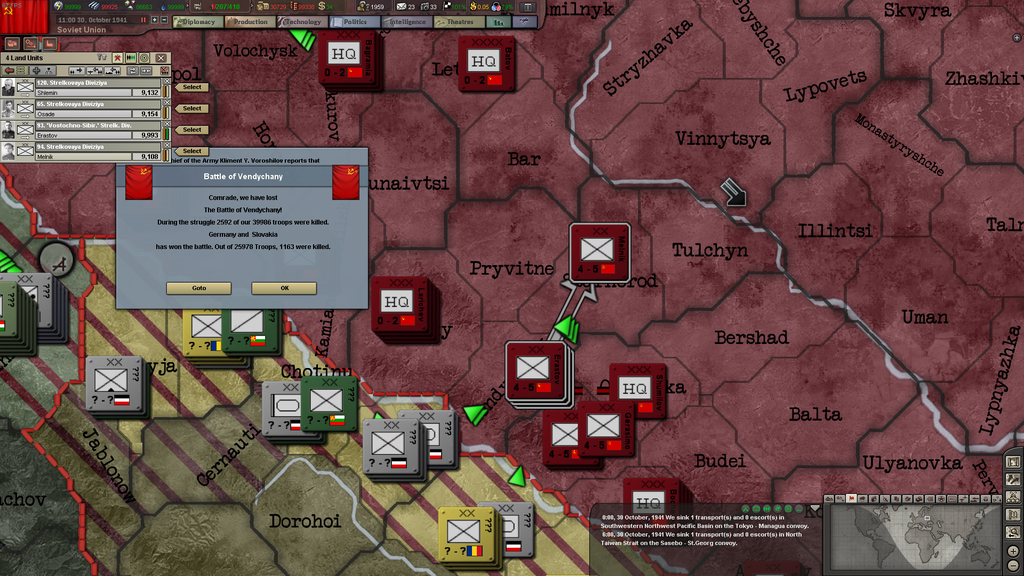
Far Eastern Front
The Soviet Far Eastern front remains in deep trouble in the second half of October. First off, a counterattack north of Vladiwostok fails spectacularly when Japanese marines and imperial guard stop the Soviet infantry dead in their tracks.
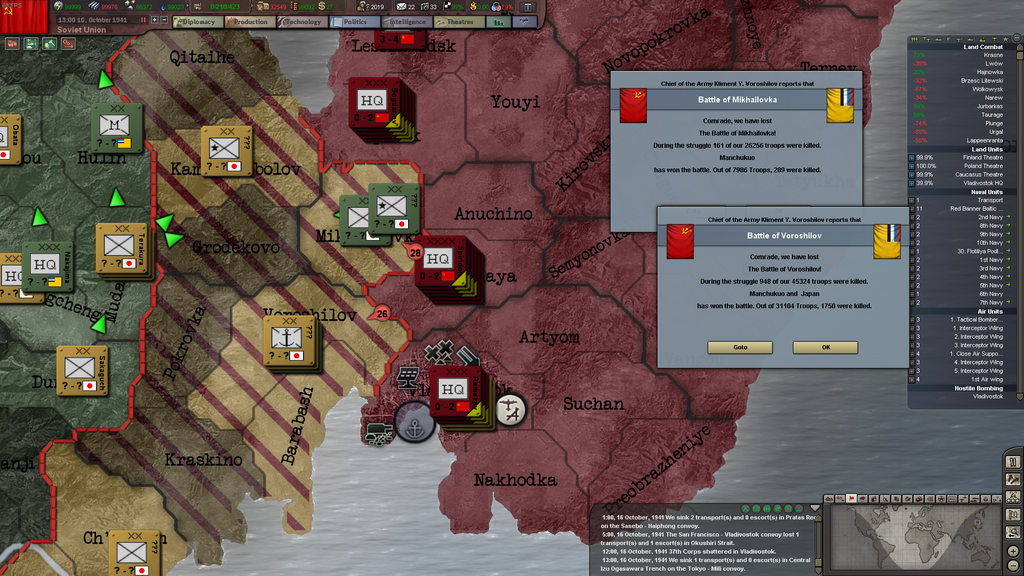
Then High Command comes to the startling realisation that Japanese infantry advancing north on Sakhalin are sufficiently equipped to cross the strait to the mainland and attack the entire army from behind. Though the frontline cannot spare a man for this threat, the Vladiwostok Garrison is put on trains northbound immediatly with orders to stop or slow down this new attack.
As this happens, fighting rages on the western outskirts of Vladiwostok as Japanese marines begin storming the fortifications erected around the city. The Soviet 2. Mountain Corps launches a desperate counterattack on Voroshilov in an attempt to stem the flow, but things are looking bad in the city. Japanese marines storm the city center in ferocious street fighting against the Soviet mountaineers. The mountaineers' trenches begin to collapse under relentless Japanese naval bombardment and the Japanese marines break through on the 19th. General Remezov of the 1st Mountain Corps is forced to order the evacuation of the Vladiwostok citadel the next day, leaving hundreds of mountain commandos dead in the streets.
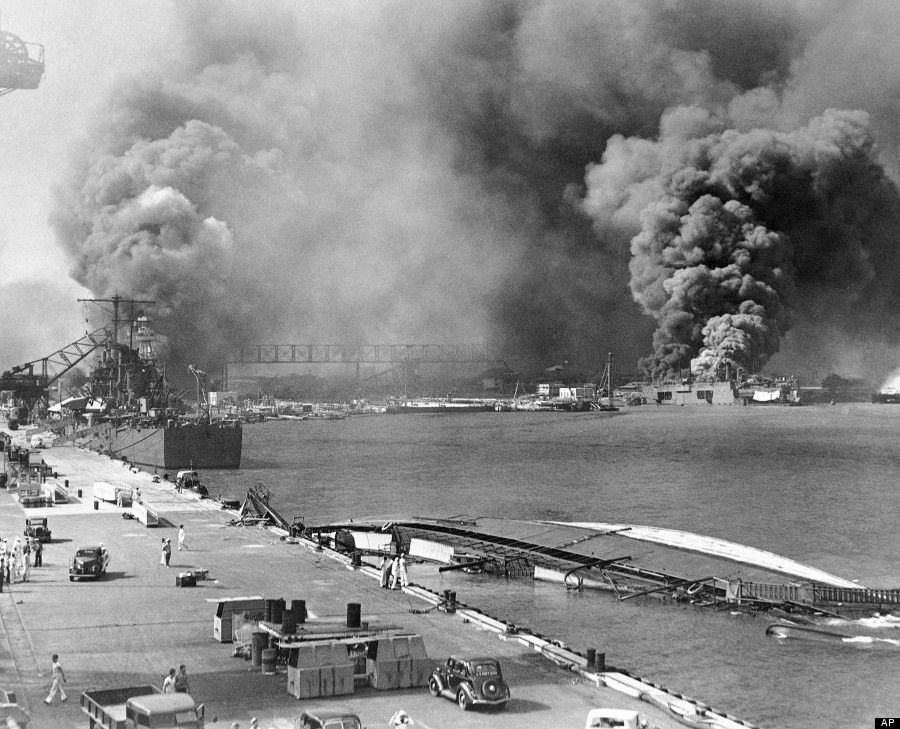
Harbour facilities in Vladiwostok burn after the garrison demolished them before withdrawing
At sea, 2 Soviet submarine flotillas raiding amongst the northern parts of the Japanese mainland are ambushed by a fleet of Japanese destroyers and aircraft carriers. spotted and unable to run away from the much faster Japanese ships, the submarine captains attempt to stand and fight. Their old submarines prove no match for Japanese depth charges however, and the entire flotilla is presumed lost with all hands on October 20th.
But Japanese troops do not advance into the city. Instead it is the Soviet mountaineers north of the city who attack and drive the Japanese and Manchurian invaders back from the city outskirts.
Immediatly after the fall of Vladiwostok the Japanese launch a great offensive in northern Manchuria, surprising and overwhelming the Soviet defenders north of the Amur river.

On the 26th, the Japanese marines attacking from Sakhalin make landfall on the mainland, the garrison rushing north did not make it in time. That same day the Japanese breach the river on the Manchurian border even further.
British operations
With the eyes of the world focused on the eastern front as Soviet and Axis forces clash in great battles, the war in Africa continues. The British advance into Libya was stopped by Italian and German reinforcements in the first weeks of October and they quickly liberate Tobruch from the Allies. But another British assault retakes the city a few days later on the 15th.
On the other side of Europe the British launch one of their famous amphibious raids on October 28th. A large fleet including battlecruiser HMS Renown, 2 battleships and 2 aircraft carriers is deployed to the Dutch coast. Targets for the motorised infantry division and 2 Indian divisions include German military command in the Netherlands, based in the Dutch government residence at the Hague and the capital city of Amsterdam.
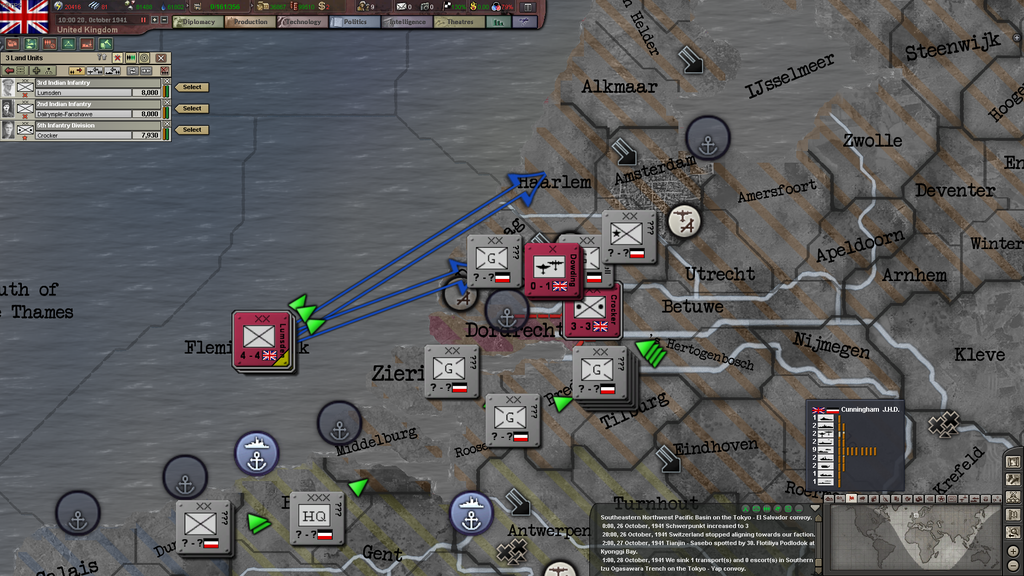
Last edited:
If you want to have better chances of encircling invading troops, you might need more defence in depth. The Rodina will endure.
I see the Brits are attempting a larger, earlier, and much more daring variation of Market Garden.

